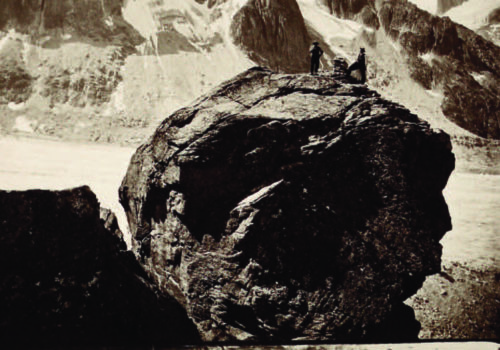Adolphe Braun (1812-1877) was a European photographer, best known for his floral still lifes, Parisian street scenes, and grand Alpine landscapes. One of the most influential photographers of the 19th century, he used contemporary innovations in photographic reproduction to market his photographs worldwide. In his later years, he used photographic techniques to reproduce famous works of art, which helped advance the field of art history.
Nothing more difficult than to photograph the mountains, problem of accessibility, light, composition, as you can read in the preface of Daniel Girardin of Vertical No Limit, catalogue Lausanne, 2017 (based on the premise that photography invented the mountain landscape by revealing it to the eyes of the world).
Jean Adolphe Braun was born in Besançon in 1812, the eldest child of Samuel Braun, a Napoleon Bonaparte European Empire police officer, and Antoinette Regard. When Adolphe was a young boy, his father had no hope for any job under the French Restauration and the family relocated to Mulhouse, a textile manufacturing center in the Alsace region along the new Franco-German border.
He showed promise as a draftsman, and when, after some political changes, his father was allowed to return to Paris to work as a policeman, Adolphe could study decorative design in the French capital. He created his first company, design ventures in 1834 and married Louise Marie Danet in November 1834, he published a successful collection of floral designs in 1842, dedicated to his wealthy friend Daniel Dollfuss-Ausset (1797-1870).
In 1843, after the tragic death of his wife (22 January 1843) Braun sold his Paris studio and moved back to Mulhouse with three young children Louise Marie Adélaïde, Adolphe Henry et Louise Joséphine. There he became chief designer in the studio of Dollfus-Ausset, which provided patterns for textiles. Dollfus Ausset organized the first daguerreian expeditions in the Alps.
In Alsace, Braun soon founded a new family, he married Melanie Baumann on 12 December 1843 and had his son Paul Gaston Braun (1845-1928). In 1847, he opened his own studio in Dornach, a suburb of Mulhouse, with his brother Charles Braun (soon married to Melanie’s sister, Sara Celie Baumann, 17 January 1845).
Soon, Braun began photographing flowers to aid in the design of new floral patterns. Making use of the recently developed collodion process, which allowed for print reproduction of the glass plates, he published over 300 of his photographs in an album, Fleurs photographiées, in 1855. These photographs caught the attention of both the Industrial circle and the Paris art community, and Braun produced a second set for display at the Paris Universal Exposition.
In 1857, Braun formed a photography company, Braun et Cie, and with the help of his sons, Henri and Gaston, and several employees, set about taking photographs of the Alsatian countryside. These were published in 1859 in L’Alsace photographiée, an ambitious album whose most complete copy was given to the new Emperor and several were displayed at the 1859 Salon. Advertising started in La Lumière” here the December 1859 issue”.
In 1864, Adolphe Braun became member of the Société française de photographie. At the same period his former commercial relations with Parisian photographers Gaudin brothers quickly degraded, still a puzzling question for historian.
By the 1860s, the Braun et Cie studio was operating in a factory-like manner, producing its own energy and all of its own materials except paper. A very unusual enterprise, conceived in an autarchical way. The studio created thousands of stereoscopic images of the Alpine regions of France, Germany, Switzerland, Italy and most of Europe. Braun also produced a number of large-format panoramic images of the Alpine countryside, using the pantoscopic camera developed by the English inventors John Johnson and John Harrison.
In the mid-1860s, Braun invested in a new carbon print method developed by English chemist Joseph Wilson Swan. After 1866, Braun used the new carbon method to create a series of large-format alpine scenes as well as hunting scenes entitled, Panoplies de gibier. He also used the new carbon print method to produce photographs of well-known works of art in places such as the Louvre, the Vatican, and the Albertina, as well as various sculptures in France, the Netherlands and Italy. This endeavor proved successful, and the Braun studio focused primarily on art reproductions.
Serge Plantureux
Serge Plantureux is a French photography collector living in Paris, France.
















